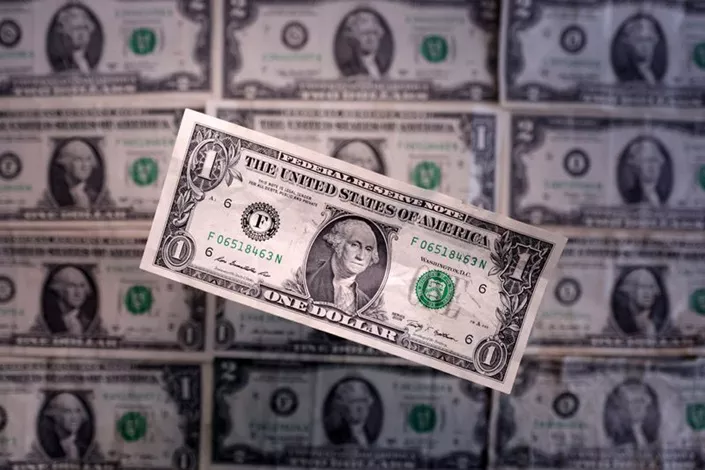In times of market uncertainty, investors typically flock to the U.S. dollar as a safe haven. However, this week, as stock markets plunged in response to U.S. tariffs, the dollar’s strength faltered. Many investors are now questioning whether the greenback’s global dominance is at risk.
On Thursday, the dollar dropped sharply, falling by approximately 1.7%—its largest one-day decline since November 2022. This drop followed President Donald Trump’s decision to impose tariffs on imports at levels not seen in over a century. Stock markets also took a hit as the tariffs raised concerns about a potential recession.
Analysts and investors point to the Trump administration’s protectionist policies, which challenge the global economic framework established after World War II, as a key factor in this shift. The growing U.S. debt burden further diminishes the dollar’s appeal, some say. If this trend continues, a loss of confidence in the dollar could threaten its position as the world’s reserve currency.
Thierry Wizman, a global foreign exchange strategist at Macquarie, explained, “What we’re seeing today is a further indication that the structure and nature of the U.S. dollar’s relationship to global markets has changed.” He added that this change reflects the shifting role of the U.S. on the world stage.
For investors, this erosion of the dollar’s safe-haven status spells trouble. A weakened dollar could lead to higher interest rates for longer, making it more difficult for the Federal Reserve to lower rates. Additionally, currencies that rise against the dollar present challenges for central banks, particularly in countries with weaker economies, as stronger foreign currencies make exports more expensive.
Sweden’s central bank deputy governor, Per Jansson, expressed concerns over the potential impact of a weakened dollar. “If the dollar’s status changes, it would create a mess for the world economy,” he warned.
Despite these concerns, the dollar remains the world’s dominant reserve currency. Trump has emphasized the importance of maintaining this status, even suggesting that a weaker dollar could benefit U.S. exports. The dollar’s competitive edge also stems from its backing by the largest economy, robust capital markets, and stable rule of law, leaving no immediate alternative.
This year, the dollar has fallen by around 6% against other major currencies, but experts believe it could recover if Trump enacts pro-growth policies like tax cuts and deregulation.
Brad Setser, a senior fellow at the Council on Foreign Relations, noted that although the U.S. may have lost some appeal as an investment destination, the dollar’s future largely depends on how the U.S. economy handles the tariff shock. He also pointed out that higher returns on U.S. bonds continue to attract investors.
This shift in sentiment is significant. At the start of the year, investors expected Trump’s tariffs to boost the dollar, anticipating that higher U.S. growth would lead to stronger demand for the currency. However, the tariffs’ impact has been more severe than expected, raising fears that the U.S. will bear the brunt of the economic fallout, with rising prices and slowing growth. This has led to several investment banks revising their predictions of a potential U.S. recession.
As money flows out of U.S. assets, demand for the dollar is weakening. In fact, U.S. stock prices have fallen by 8% this year, while markets in Germany and Hong Kong have risen by around 12% each.
In response to the tariffs, French President Emmanuel Macron has urged European companies to suspend planned investments in the U.S. Meanwhile, Paresh Upadhyaya, director of fixed income and currency strategy at Amundi, pointed out that the three key factors that supported the dollar—U.S. exceptionalism, high interest rates, and strong portfolio flows—are all weakening due to Trump’s tariff policies.
Deutsche Bank and bond giant PIMCO have both expressed concerns about a possible crisis of confidence in the U.S. dollar. Satori Insights’ Matt King believes that outflows from U.S. assets are likely to continue, exacerbating the dollar’s decline.
The dollar, often referred to as “King Dollar” for its strength, now faces an uncertain future. UBS strategist James Malcolm drew comparisons between the current situation and the 1980s, when the U.S. was pressured to weaken the dollar to address widening deficits. He predicted that a similar outcome could happen today, with the dollar continuing to fall.
While the idea of a “Mar-a-Lago Accord” to weaken the dollar remains speculative, concerns about the weaponization of finance, particularly the dollar, are growing in Europe. Antonio Fatas, a macroeconomist at INSEAD, emphasized the risks of such erratic behavior, pointing out that the lack of a viable alternative to the dollar would make this shift painful for the global economy.
In short, the dollar’s dominance is being tested like never before, and while its long-term future remains secure for now, its role in the global economy could be facing a pivotal moment.
Related Topics:


